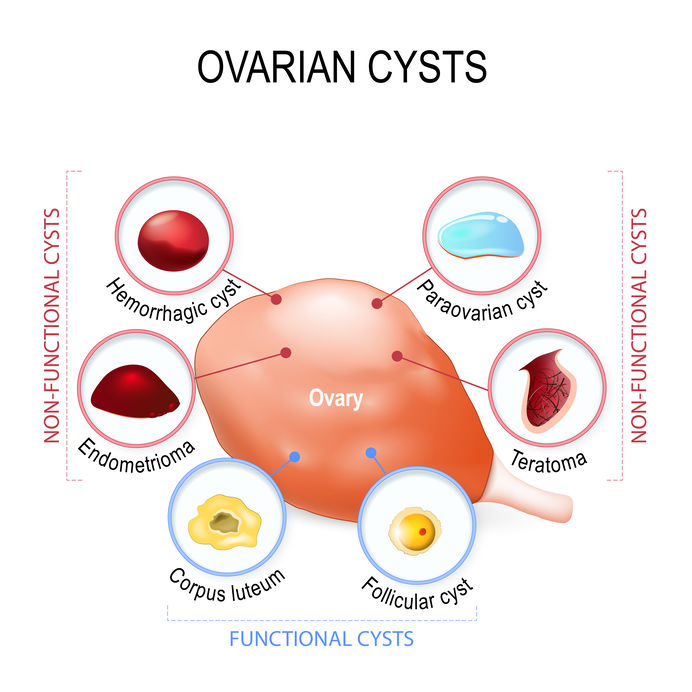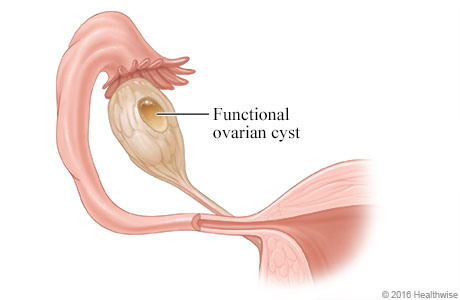An ovarian cyst is a sac or pouch filled with fluid or other tissue that forms in or on an ovary. Ovarian cysts are very common. They can occur during the childbearing years or after menopause. Most ovarian cysts are benign (not cancerous) and go away on their own without treatment. Rarely, a cyst may be malignant (cancerous)
There are two main types of ovarian cyst: functional and pathological.

Ovarian Cyst Symptoms
In most cases, cysts do not cause symptoms. Many are found during a routine pelvic exam or imaging test done for another reason. Some cysts may cause a dull or sharp ache in the abdomen and pain during certain activities. Larger cysts may cause twisting of the ovary. This twisting usually causes pain on one side that comes and goes or can start suddenly. Bleeding into or rupturing of a cyst may cause sudden, severe pain.
cause a dull or sharp ache in the abdomen and pain during certain activities. Larger cysts may cause twisting of the ovary. This twisting usually causes pain on one side that comes and goes or can start suddenly. Bleeding into or rupturing of a cyst may cause sudden, severe pain.
In any of the above cases, symptoms may include:
- Pelvic/abdominal pain or discomfort
- Painful intercourse
- Bloating or abdominal distension (swelling)
- Difficulty passing urine or frequent need to urinate
- Abnormal bleeding or irregular periods or bleeding after menopause
- Feeling of fullness after only eating small amount of food
Since most ovarian cysts show no symptoms or signs, they often go undiagnosed. If your obstetrician–gynaecologist (ob-gyn) or general practitioner thinks that you may have a cyst, the following tests may be recommended to find out more information:
Pelvic ultrasound An ultrasound scan is the primary test to diagnose the presence of a cyst, identify its location and determine whether it is solid or filled with fluid.
CT or MRI scans An MRI or CT scan may sometimes be necessary if an ultrasound is inconclusive regarding the location or nature of the cyst. MRI scans use magnetic waves to produce detailed images of internal organs. CT scans use body imaging devices to create cross-sectional images of the internal organs. Both can provide more in-depth analysis and diagnose medical conditions.
CA-125 blood test Where there is a tumour present, the blood levels of the CA-125 protein are often elevated, which could signal ovarian cancer. As such, this blood test is used to help determine whether an ovarian cyst could be cancerous. However, elevated CA-125 levels can also occur in non-cancerous conditions, such as endometriosis, uterine fibroids and pelvic inflammatory disease.
Treatment of an ovarian cyst depends upon its cause, size and appearance and the symptoms the patient may be experiencing. Age and menopausal status should be factored as well, any significant cyst in a postmenopausal woman should be removed.
Possible treatments include: Expectant Management Where a cyst is small, simple and does not cause any symptoms, simply monitoring the cysts every 3 months until resolution may be advised. In many cases, the ovarian cysts will remain the same size, decrease, or even disappear, in which instance no surgery is required. However, in cases where the cyst increases in size or becomes symptomatic, surgical treatment may be recommended.
Most functional cysts tend to disappear on their own without causing any problems to the woman, so this option prevents a woman undergoing treatment where it is not necessary.
Contraceptive pills These drugs are used to stop ovulation and can therefore, help prevent some types of new cysts from developing. They can also help reduce the risk of developing ovarian cancer, however they don’t aid in the resolution of the current cyst.
Surgery Large and or problematic cysts should be surgically removed. This may involve either removing the cyst or the entire ovary. Two types of surgical approaches are used to remove ovarian cysts; laparoscopy and laparotomy. In the vast majority of cases, the operation is done via laparoscopic (keyhole) surgery.
Laparoscopy Involves visualisation of the pelvis using a small telescope through the belly button. Additional 5-10mm ports are used to facilitate the passage of instruments, allowing the surgeon to remove the cyst or ovaries. The tissue is placed in a bag, removed in pieces through the keyhole incision and sent for testing.
Minimally invasive keyhole surgery avoids the need for a large incision and has the advantage of reduced hospital stays, quicker recovery times and an easy return to normal life.
Laparotomy Where a cyst is exceptionally large or there is a high chance that it could be cancerous, a laparotomy might be the best medical option. This involves making a single large incision on the abdomen to allow for easy removal of the cyst or entire ovary. This type of procedure results in significantly more pain and longer periods of hospitalisation.

